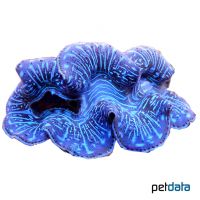Derasa Clam (Tridacna derasa)
| Derasa Clam Tridacna derasa | |
|---|---|
| Name | Derasa Clam |
| Name Lat. | Tridacna derasa |
| Family | True Cockles |
| Family lat. | Cardiidae |
| Order | Cardiidas |
| Order lat. | Cardiida |
| Origin | Indo-West Pacific |
| Diet | Autotrophic, planktivore |
| pH | 8.1-8.4 |
| Hardness | 8-10 °KH |
| Lighting | High |
| Current | Moderate |
| Behavior | Peaceful |
| Keeping | Solitary |
| Care Level | Moderate |
| Life Span | N/A |
| Protection | CITES Appendix II; EC Annex B |
| Metric Units | |
| Size | 50 cm |
| Temperature | 22-27 °C |
| Salinity | 33-36 ‰ |
| Aquarium | 500 l |
| US Units | |
| Size | 20" |
| Temperature | 72-81 °F |
| Salinity | 1.020-1.025 sg |
| Aquarium | 130 gal |
Distribution and habitat
The distribution area of Tridacna derasa is the East Indian Ocean as well as the West Pacific and the Coral Sea, from the Cocos Islands through Indonesia and Australia to Fiji. They live on outer reefs in 4-20 m depth.
Maintenance
They should be positioned on the sandy bottom, in a place with high light intensity and moderate, alternating flow. As a substrate, only lime-rich, heavy metal-free substrates should be used
To ensure water quality, filters, skimmers and heaters are necessary, as well as pumps to simulate tides, swells and bottom currents. It is recommended that live stones be used to set up the aquarium. The bacteria living in the porous stones act as a biological filter. The lighting must correspond to the species-appropriate day-night rhythm of the animals
| Salinity: 33-36 ‰ | pH value: 8.1-8.4 |
| Carbonate hardness: 8-10 °KH | Nitrate content: 2-8 mg/l |
| calcium content: 420-450 mg/l | Nitrite content: 0.0-0.05 mg/l |
| Magnesium content: 1.250-1.350 mg/l | phosphate content: 0.01-0.1 mg/l |
Regular addition of trace elements, especially calcium, is recommended. For salinity, an average value should be aimed for, which may only vary slightly by +/- 0.5 ‰. Ammonia and ammonium must not be measurable. Special attention shall be paid to consistently good water quality and water values.
Diet
They are filter feeders and in their tissues live zooxanthellae, which are unicellular symbiotic algae that provide them with assimilation products of their photosynthesis (high light requirement). The zooxanthellae promote growth and provide additional food to the plankton and small particles that are collected in large quantities from the water current. Thus, in addition to the food produced in the aquarium during fish feeding (mysis, krill, Artemia, etc.), commercial supplementary food in the form of phyto- and zooplankton should be offered regularly, especially for small mussels.
Regular and varied feeding promotes health and prevents deficiency symptoms.
Behaviour and compatibility
They should not be kept together with fish or lower animals that harass or consider their mantle lobe as food (e.g. wrasses or triggerfish). They can be well socialized with corals, as they are insensitive to cnidarian venom.
Reproduction and breeding
They are protandric hermaphrodites. Sperm cells and eggs are released into the water with a time delay to exclude self-fertilization. Larvae hatch approximately 12 hours after fertilization and undergo numerous metamorphoses until they can feed. The larval phase is completed after 3-4 weeks. They lose their byssus filaments very early and then stand loosely.
Species protection
Species protection: WA Appendix II; EU Appendix B. The proof of purchase is the required proof of origin for the animal. Please keep it safe! Your pet store will be happy to provide you with further information.
Important
They are one of the hardiest in their family and unlike other Tridacna species, they are not sessile. The additional lighting with actinic light (short wavelength, violet-blue light) is very beneficial for their growth (zooxanthellae).
For the necessary uniform supply of calcium carbonate and magnesium, a calcium reactor and a magnesium metering pump are recommended.
If different species are kept together, make sure that fish and invertebrates match each other in terms of water quality and temperature requirements as well as their social behavior, and that the setup meets the ecological needs of all species kept together. Further literature can be found in your pet store.
References
Text: petdata; Image: petdata
Source: FOSSÁ & NILSEN (1995): Korallenriff-Aquarium Bd. 6, Birgit Schmettkamp Verlag; ENGELMANN & LANGE (2011): Zootierhaltung - Tiere in menschlicher Obhut: Wirbellose, Verlag Harri Deutsch
